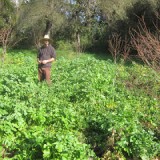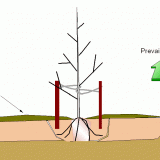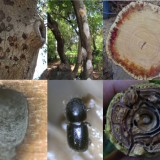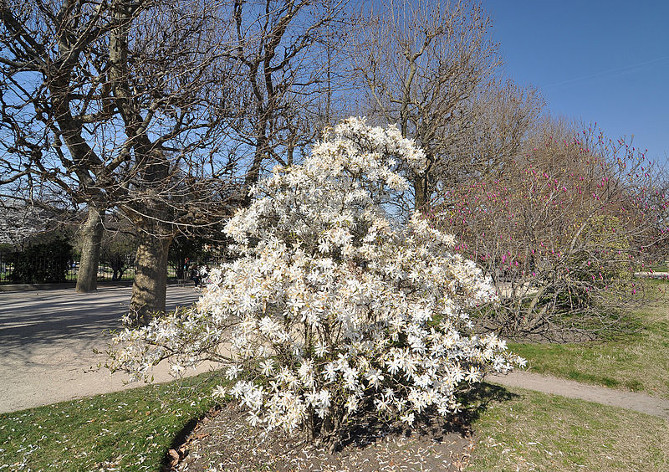
Trees and people, happy together. The Mall and Literary Walk, Central Park, NYC. Photo by Ahodges7.
Trees are dying all over Los Angeles, because of the drought. No one seems to think they need to be watered.
Trees which are not simply dying of thirst are being ripped out and replaced with “water saving landscapes” of succulents, cactus and gravel.
Both of these trends are disturbing, and are the result of ignorance more than bad intent. Our culture as a whole is green blind if not outright biophobic. I’ve come to understand that most people don’t even really see plants, except as a vague green background to their busy lives, and even fewer people understand plants and the value they bring to our lives and the world at large.
I’ve been traveling a lot this summer, taking refuge in green places which restore the soul. Returning to LA has been hard, because all of the plant life here is so very stressed. When I’m outside, it’s almost as if I can hear a constant, low-level cry of misery from the land, and that pain resonates in me, creating a deep sense of helplessness and sorrow. My strategy for dealing with this for the past couple of weeks has been to hide indoors and bury myself in books–to just shut down.
But I seem to have run into the limits of self-pity, and now I’m trying to figure out what I can do to help the situation. This post is a small gesture in that direction. I’m beginning with trees, because they are the lynchpin of the loving landscape.
In defense of trees
Shrubs and annuals come and go. Trees are long term residents of the landscape, surveyors of our lives. Above and below ground they knit together communities on many levels. They deserve special attention. They deserve to be valued and cherished for what they are, more than simply what they do for us. That said, they do a whole heck of a lot for us:
- In mercenary, real estate terms, trees create street appeal and bump up property values by thousands of dollars. This, though, is the least part of their true value.
- Trees cast shade, which cools the ground, which cools the environment at large, countering the urban heat island effect. They also cool the air by passing water through their leaves. A healthy urban forest makes for a much more liveable city for us all. (The city of Melbourne understands this.) And trees clustered around your own house make your home cooler in the summer, reducing your energy bills. Low lying cactus and succulent plants do little or nothing nothing to cool the city, while gravel, concrete and artificial turf make your yard a blistering heat trap.
- Trees help the land absorb rain, increasing ground water levels and preventing destructive run off and storm flooding. (See this and this.) A single tree can absorb thousands of gallons of rain water as it falls, like a giant sponge. What will happen to the dry slopes of California this winter, when the winter rains come, and our trees are gone, from stress and fire? Mudslides my friends, and lots of them. I’m already dreading it. But this isn’t just a California problem. Crazy weather is the norm the world over now, and trees are one of our best buffers against the worst of it.
- Trees don’t only hold water in the ground, they share it with other plants. Having a big tree in your yard is like having a pump and well which you don’t have to maintain.
- Trees make for clean water. By absorbing all that storm water, they pull the filth from our streets into the soil, and the soil cleans it, pro bono. (This is one of the many benefits of healthy soil, another important player in environmental health.) If that storm water runs unchecked, it just dumps all of the oil and fertilizer and insecticides and poo straight into the nearest waterway.
- Trees absorb and store carbon, directly mitigating climate change–and they indirectly mitigate the change as well, by helping to temper the effects of storm water, high winds, high heat, etc.
- Trees improve our air quality.
- Trees create food and habitat for birds, insects and mammals. We humans don’t like to share resources with the rest of creation, but trees support life of all sorts, with no trouble to us. Or maybe not, if squirrels are stripping your fruit trees clean! So we might have a vested interest in fruit trees–but all trees are beneficial to other life, above and below ground. Think of each tree as a city, teaming with life which is mostly invisible to us, but vitally important to the world.
- Trees heal the soul. They give us shelter from the sun and the rain. They give us a place to read and dream. A place to hide and climb. An anchor in a shifting landscape of time and movement. We’ve known since the 1980’s that they even speed our recovery when we’re sick.
These points just scratch the surface of what trees do for us. For more, see Tree People’s Top 22 Benefits of Trees.
Trees don’t ask much of us, but offer so much in return. I feel the least we can do is treat them well. They are valuable, long lived, complex entities. It is worth calling a professional arborist to give them a proper pruning, or to consult if they look stressed. Yes, this costs money, but removing a mature tree once it has died from neglect, disease or bad pruning is a much more expensive proposition.
If you live in a drought-stricken area, water your trees--even if you’ve never watered them before. They don’t have the resources they once had, and while they’ve been hanging on like champs for four years, they are beginning to give up. I see it everywhere.
Watering trees in a drought is a long-term investment. It is even reasonable to plant a new tree, as you would light a candle in the darkness. Don’t water anything else in your yard, if you must, but save your trees.





I’d suggest the evidence indicates that our culture is anything *but* ‘biophobic’. Naturally, living in an area like LA which is completely overpopulated and therefore water-stressed, it may seem that things are sad all over. This simply isn’t so – and, living as we do here in the rural northeast (and watching yet another afternoon downpour), I can only suggest that if greenery is your thing, try relocating to somewhere that has some. 🙂
http://www.greenoptimistic.com/united-states-trees/#.VdYTJvlVhBc
First, it’s not so easy for most folks to pick up and leave their homes because of family, friends, jobs, etc. — even if living conditions aren’t perfect.
More than that, though, it’s not feasible for all of us to flee the cities for the rural parts of the world, because then those bits would be ruined in turn. (Californicated, even) More than 50% of the world’s population now lives in cities, and that number is only going to grow. It is to the benefit of both humans and the land that we learn how to make the cities more liveable and biodiverse so we can preserve our open spaces.
Third, Los Angeles isn’t over-populated, it’s under-managed. We could support LA on rainfall if we had the will.
What if its an almond tree?
I’m not sure what you mean– do you mean agricultural almonds? That is a sad thing indeed–farmers can’t afford to plant water-wise crops, but it profits them amazingly to plant thirsty almonds. That’s the free market for ya!
Dh and I just returned from a camping trip at San Simeon State Campground, where we’ve camped each year for the last few years. This year, it was heartbreaking to see how many of the trees had died (most of these seemed to have signs of Polyphagous Shot Hole Borer, followed by fungus in the holes, followed by termites). As in, some places it was every 2nd or 3rd tree. While we’ve always camped in that “dry camping” part of the campground, the thought that struck me is that many of the tree deaths in that part of the campground were because they turned off the spigots that had previously been dotted throughout. The runoff from campers using those spigots was likely helping many of those trees limp through the drought, but now that the spigots were turned off so that the *people* wouldn’t use them, it also effectively shut that runoff from going to those trees. Also interesting that there was one really healthy tree next to where they were repairing the underground pipes. Apparently, no one knew that there were old valves leaking around the campground until they shut off all the water and then found that the meter was still running. In this latest effort to fix those valves, I suspect that that one healthy tree is now losing it’s last water source as well. We left from our trip with a bittersweet feeling knowing that this, and many more of the trees, likely won’t be there when we return next year.
Sooooooo many unintended consequences for our beautiful tree friends everywhere. And we won’t even see the half of it until the wind starts to wail later this Fall/Winter and the additional dead/dying ones start to reveal themselves. Oh – and to add, at least 65 trees are going to get the chainsaw in the Pasadena Arroyo because they are also infested with Polyphagous Shot Hole Borer.
Oh, now, that is a very sad story. And so unsurprising, these days. The Polyphagous Shot Hole Borer loves water stressed trees, so this all is a perfect storm of sorts.
And you’re right, I mentioned mudslides, but forgot about trees just falling over. I don’t know how I could forget in the wake of those poor kids in Pasadena.
It should be an interesting winter, that’s for sure.
I would call it “bioblind” as an alternative to “biophobic”. We are not having a drought here in Ohio, but we did have a very dry July followed by a few weeks of dryness in August. When I ran through my neighborhood last weekend, I was sad to see many of the smaller trees showing signs of stress in yards that were sprinkling their lawns…but the smaller trees are perched on landscaping mounds or on the tree lawn and didn’t benefit from the moisture. Green grass and dying trees.
Haha, I just saw that you wrote “green blind” which is the same thing as “bioblind”. I agree that few people pay attention to the things growing around them. But is this because in urban/suburban areas we’ve made our habitat so bland as to not warrant the attention?
That’s a really good point– we do have a bland habitat! I’m going to mull on that a bit.
I was going to write a question about what to do about mature trees in a drought, and then you answered it at the end of the post! Our trees help us keep our energy costs low in our house by giving us fabulous shade. Not to mention how pretty they are.
Your paragraph expressing your experience of the “low-level cry of misery from the land” is *such* a beautiful acknowledgement of exactly what I’ve been feeling recently – and one reason why, after thinking I’d live in Southern California for the rest of my life, I recently moved. (Other, even bigger, reasons were present, but this was very definitely a factor.)
Thank you for putting words to what I was feeling. And thank you for this post on behalf of trees everywhere, especially in drought-ridden areas.
Thank you for this wonderful article. Trees are life. They are essential to our very existence on this earth at the global level. I have also observed here in northern California that people have not been watering their trees as part of the moratorium on watering lawns. It was encouraging to hear on the news that we are still encouraged to keep watering our trees through this drought. I’ve been watering the trees in the park that are just on the other side of my back fence as they look very stressed. And also my neighbors trees just on the other side of my side fence because she is gone most of the time and her trees were extremely stressed putting out seed pods in huge amounts which can be a sign that the tree is struggling for survival. Cutting down trees during a drought if they are healthy is the worst thing we can do. Trees and correctly planned greenery helps retain moisture and creates the micro environment which precipitates moisture and rain. I recommend a book titled Sowing Seeds in the Desert by Masanobu Fukuoka to learn more about how we can regreen our environments even in desert like conditions. We should all become cognizant of the trees in our communities and take responsibility to nurture them when we see that they are in distress.
Yes, yes, YES!!! We’ve been away for 3 months and our landscape has already been on minimal watering but I left instructions for each of my trees to be flooded on a rotating basis.
I was in terror of losing even one of them. Several are very old and huge and may be able to take care of themselves but I wouldn’t know now to replace a tree in a drought. And every tree lost is a step closer to desertification.
Here in Palm Toast Florida, the City requires a minimum of 6 trees be planted for every home built. Helps keep the summer temperatures tolerable too. Trees add a lot of beauty and benefits. Look at some of the 4th World Countries who harvested all their trees for cooking/heating fuels. Now they make manure briquettes and call that progress. Plant fruit/nut trees if you can. At least you’ll get something in return for all the leaves you have to rake!
I feel like this should be a public service announcement to all Californians. Thank you, Kelly.
Thank you for this post. This issue has been on my mind a lot considering we’ve been seeing so much development here in Portland that has come at the expense of chopping down big trees. I came across this map showing the effects of urban trees on heat and pollution:
http://map.treesandhealth.org/
Unfortunately it doesn’t show LA :^\
I get what you’re saying but I’m just not sure LA is the place to be if you want lots of trees. Before they brought in all the water LA wasn’t a place full of trees – so of course now that water is stopping the landscape will go back to something more natural.
http://www.kcet.org/updaily/socal_focus/history/la-as-subject/when-la-was-empty-wide-open-socal-landscapes.html
Actually, the earliest Spanish reports of the place which became LA said that it was filled with marvelous oaks, and you could ride all day beneath them and never leave their shade. The photos in that report are from a later time, after the racheros, after the farms.
I should add in all fairness that I”m sure some of the LA basin was grassland as well– and some chaparral and some coastal scrub. It’s a big, diverse area and it’s true it was not all tree-sy.
However, a city is a garden, so we could design it any way that makes sense. Trees do so much good holding and absorbing water that water invested in them is not wasted.
Thank you for this post. I’m in Texas and I mourn the loss of your greenery, the trees, the shrubs, even the green grass that’s being replaced with plastic astro turf (Ay yi yi!!). Rain is so essential. I read news from California and it inevitably makes me 1) thankful that my north Texas location still gets regular rain fall 2) think more honestly about what I could or actually need to start growing at home. I’m a big green smoothie fan and frankly, embarrassingly, where does my organic kale/chard come from? Drought stricken California. Your thoughstyling posts make me realize I need to do more with the land I have out my front and back door, if only to alleviate the burden on your state in some small way. (I know, economically speaking that’s nonsense, but water wise, I think it’s closer to the truth).
3)it makes me think hard about change – we don’t really have the luxury of climate stability and predictability anymore (my opinion). Things that worked a year ago might not work now. I read a comment on the arch druid report a proposal that perhaps California is shifting to a desert climate, where rains would fall in the summer season, and not in the winter. That has some serious implications for the state, given it’s agricultural economy and the way that we the first class world likes to use/waste water. I recently was out in NV for a work trip and took the time to go to a ‘botanical’ garden out there. SUCH a different botanical landscape than I was used to, but there was beauty in the details. The various cactii are brilliant in the way that they grow and utilize the sparse elements and abundant sunlight. The plants are smaller and far more conservative with their growing efforts – because that fits the climate. It’s different, but yet has a beauty all it’s own. I’m sure if one where to slow down and study the botany around them in the desert, they would find edibles and sources of water, but it would be a different harvest than the standard gardens we’re used to. All that to say that change doesn’t mean people were previously used to.
I can’t predict California’s climate future, but I can hope that all of the new trees you’ve inspired people to plant will survive. I hope the trees that you’ve inspired people to start watering again survive and flourish to the benefit of everything around them. Trees are so important, as you’ve said. There are varieties that survive in arid climates. I hope people are inspired to plant many different varieties. (Variety is the spice and a sort of insurance of life).
Thank you for your beautiful writing, and for honestly sharing your feelings and knowledge with us. I appreciate it. I’m sending you best wishes for your future in LA. I know you love the city and I believe that you are a positive force for change there. As tempting as it is to tell you to migrate elsewhere to greener climates, I know you’re doing invaluable work right where you are and I applaud you for it.
I urge anyone concerned about over watering to read another excellent article that discusses what is sensible water use in this drought, how harmful it really is to just stop watering all plants and just how much water is used by residential users (5-8% in California). The environment is complex and to lose bees, butterflies, trees through misguided good intentions does not make sense.
http://blog.anniesannuals.com/2015/04/23/home-gardeners-are-not-the-problem/